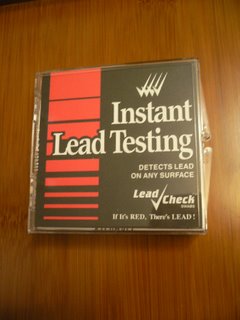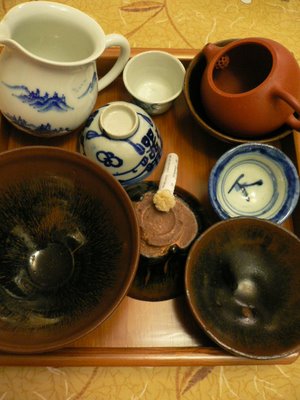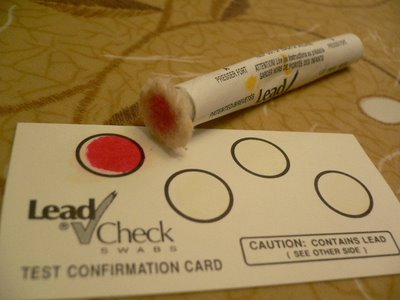"Lead in Ceramics
Lead can be found all around us in dishes, fine crystal, painted walls and woodwork, toys, furniture, antique varnishes, solder, dust and soil. The effects of lead poisoning are cumulative throughout our lifetime, therefore it is important to limit our exposure to it.
In the ceramics industry, some lead glazes are still used to color or decorate and to smooth the surface of ceramic products. As long as the clay and glazes are compatible, and these glazes are properly fired (at a high enough temperature and for an appropriate amount of time), the lead is not likely to leach through the surface.
With constant use and scrubbing, ceramic products can wear down over time, and may allow lead to leach through. Hot and highly acidic foods, and prolonged time of contact, will increase lead leaching from such damaged surfaces. Antique, highly decorated ceramics are the most likely to leach lead.
You might be able to visually detect lead leaching if ceramic items show a dusty or chalky gray residue on the glaze after they are washed. When testing for lead content, be sure to test the surface that comes in contact with the food."
 That page also provided a link to LeadCheck, a company providing lead checking swabs. So, I went ahead and purchased the kit to test my ceramics and get a scientific answer to this recurring question (urban legend?). The kit has arrived yesterday and I first started with my decorated Qing dynasty cups. Some have chips, which makes it possible to check the inside as well as the outside glaze.
That page also provided a link to LeadCheck, a company providing lead checking swabs. So, I went ahead and purchased the kit to test my ceramics and get a scientific answer to this recurring question (urban legend?). The kit has arrived yesterday and I first started with my decorated Qing dynasty cups. Some have chips, which makes it possible to check the inside as well as the outside glaze.Result: negative. No lead found. Excellent! There was still liquid in the swab and I then continued with my other antique ceramics: the Qing wine cup, the Xi cup, the black Tenmoku. Negative results all the way!
 Then, I tested my new ceramics and even my Yixing teapots. As you can see below, the swab remained white (except for the dust).
Then, I tested my new ceramics and even my Yixing teapots. As you can see below, the swab remained white (except for the dust). The only way to make it turn red was by using the confirmation card below:
The only way to make it turn red was by using the confirmation card below:  Conclusion: Readers who plan to buy or bought my antique/modern teaware can drink tea in total peace of mind. The scientific Lead Check test shows no traces of lead in the tea wares I selected for their high quality and artistic design.
Conclusion: Readers who plan to buy or bought my antique/modern teaware can drink tea in total peace of mind. The scientific Lead Check test shows no traces of lead in the tea wares I selected for their high quality and artistic design.

to know if this is accurate wouldn't you need to get at least one positive after brushing a known lead-glazed ceramic. i'd hazard to think all negatives worries me as much as none.
ReplyDeleteAll negative does seem slightly worrying:
ReplyDelete"The only drawback is that overseas experience with many of these test kits suggests that false negative and false positive results may occur."
http://www.environment.gov.au/atmosphere/airquality/publications/ceramics.html
Thank you for the useful link, Hanna. It says that lead is common in heavily decorated pieces, especially when it's done over the glaze. The items I tested don't enter this category and it's therefore not surprising or worrying to get these negative results.
ReplyDeleteYou are supposed to use a different swab with each area you are testing, not use the same one over and over, which I confirmed with the instructions. I'd be weary.
ReplyDeleteThe instructions don't say to use a different swab with each area. They say that "For each swab, all tests must be completed within two (2) minutes." The plural on tests clearly indicates that you can use the same swab for tests on several items (as long as the color doesn't turn positive) within 2 minutes time.
ReplyDelete